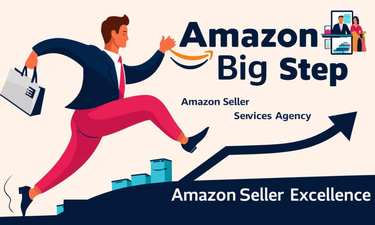How to Find Profitable Products to Sell on Amazon
Selling on Amazon is a lucrative business opportunity, but success starts with choosing the right products. Finding profitable products requires strategic research, data analysis, and understanding customer demand. In this guide, we will break down the best methods and tools for finding winning products to sell on Amazon.
Amazon Big Step
3/28/20253 min read


1. Understanding What Makes a Product Profitable
Before diving into product research, it’s crucial to understand what makes a product worth selling. A profitable Amazon product typically meets the following criteria:
High Demand: Strong search volume and consistent sales trends.
Low Competition: Less saturation in the marketplace.
Healthy Profit Margins: At least 30%-50% profit after Amazon fees.
Lightweight & Small Size: Reduces storage and shipping costs.
Evergreen or Trending: Steady demand throughout the year or capitalizing on emerging trends.
2. Using Amazon’s Own Data for Product Research
Amazon provides valuable insights into what customers are searching for and buying. Here are some ways to leverage Amazon’s platform:
A. Amazon Best Sellers
Check the Amazon Best Sellers page to see top-performing products in different categories. Look for:
Products with consistent rankings over time.
Items that aren’t overly dominated by big brands.
Moderate competition with room for new sellers.
B. Amazon Movers & Shakers
This section highlights fast-growing products. It’s a great place to spot trending products before they become highly competitive.
C. Amazon Search Autocomplete & Keywords
When you type a keyword into Amazon’s search bar, it suggests popular terms based on customer searches. These suggestions indicate real-time demand.
3. Using Third-Party Product Research Tools
While Amazon provides useful insights, third-party tools can provide more detailed data on sales trends, competition, and profitability.
A. Helium 10
Helium 10 is one of the most powerful tools for Amazon product research. Key features include:
Black Box: Filters products by niche, revenue, and competition.
Cerebro: Reverse ASIN lookup to analyze competitors’ keywords.
Trend Tracker: Identifies seasonal trends and long-term demand.
B. Jungle Scout
Jungle Scout is another popular tool offering:
Product Database: Over 70 million Amazon products for analysis.
Opportunity Finder: Identifies low-competition, high-demand products.
Sales Estimator: Predicts monthly sales volume.
C. AMZScout
AMZScout provides real-time sales estimates, product trends, and competition analysis to help sellers make informed decisions.
4. Evaluating the Competition
Once you find potential products, assess the competition to determine if there’s room for entry.
A. Analyze Competitor Listings
Look at the top sellers in your niche and evaluate:
Number of Reviews: Products with fewer reviews are easier to compete against.
Listing Quality: Poorly optimized listings present an opportunity to outperform.
Price Points: Ensure you can price competitively while maintaining profit margins.
B. Check the Brand Dominance
Avoid categories where big brands dominate, as they often have strong brand loyalty and advertising budgets.
C. Read Customer Reviews
Customer feedback reveals common product complaints, allowing you to improve upon existing products and stand out.
5. Profitability Calculation & Fee Estimation
Even if a product has high demand, it must also be financially viable. Use Amazon’s FBA Revenue Calculator to estimate costs and profitability.
Key Costs to Consider:
Amazon Referral Fees (Usually 8%-15% of the selling price)
FBA Fees (Storage, picking, packing, and shipping)
Cost of Goods Sold (COGS)
Shipping Costs from Supplier
Advertising Expenses (Amazon PPC)
Aim for at least 30%-50% profit margins to ensure a healthy business.
6. Finding Reliable Suppliers
Once you validate a product, the next step is sourcing. Here are the best options:
A. Alibaba
Alibaba is the largest supplier directory, offering competitive pricing and bulk options.
Contact multiple suppliers and request samples.
Negotiate pricing and minimum order quantities (MOQs).
Verify supplier credentials and reviews.
B. U.S. Suppliers & Wholesale Distributors
If you prefer faster shipping and lower MOQs, consider domestic suppliers:
SaleHoo
ThomasNet
Worldwide Brands
C. Private Labeling
For better branding and differentiation, consider private labeling, where you customize packaging and branding for a unique presence.
7. Testing the Market Before Scaling
Before committing to large inventory orders, test your product’s demand:
Order small quantities to gauge interest.
Run Amazon PPC ads to assess conversion rates.
Use FBM (Fulfilled by Merchant) before switching to FBA.
8. Scaling Your Amazon Business
Once you find a winning product, scale by:
Expanding to multiple variations (size, color, bundle options).
Selling on international Amazon marketplaces.
Launching complementary products in the same niche.
Final Thoughts
Finding profitable products to sell on Amazon requires thorough research, competitor analysis, and financial planning. By leveraging Amazon’s data, using research tools like Helium 10 and Jungle Scout, and validating profitability, you can set yourself up for success in the competitive Amazon marketplace.
Start researching today and uncover your next winning product!
Expertise
Your partner for Amazon growth and success.
Services
Insights
connect@amazonbigstep.com
+1 (859)4182348
© 2025. All rights reserved.
